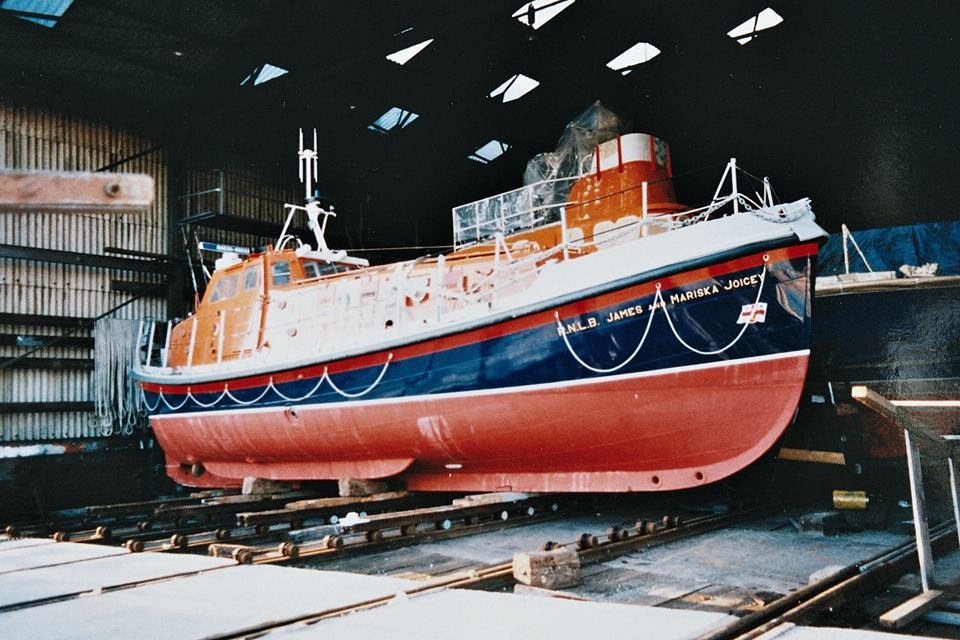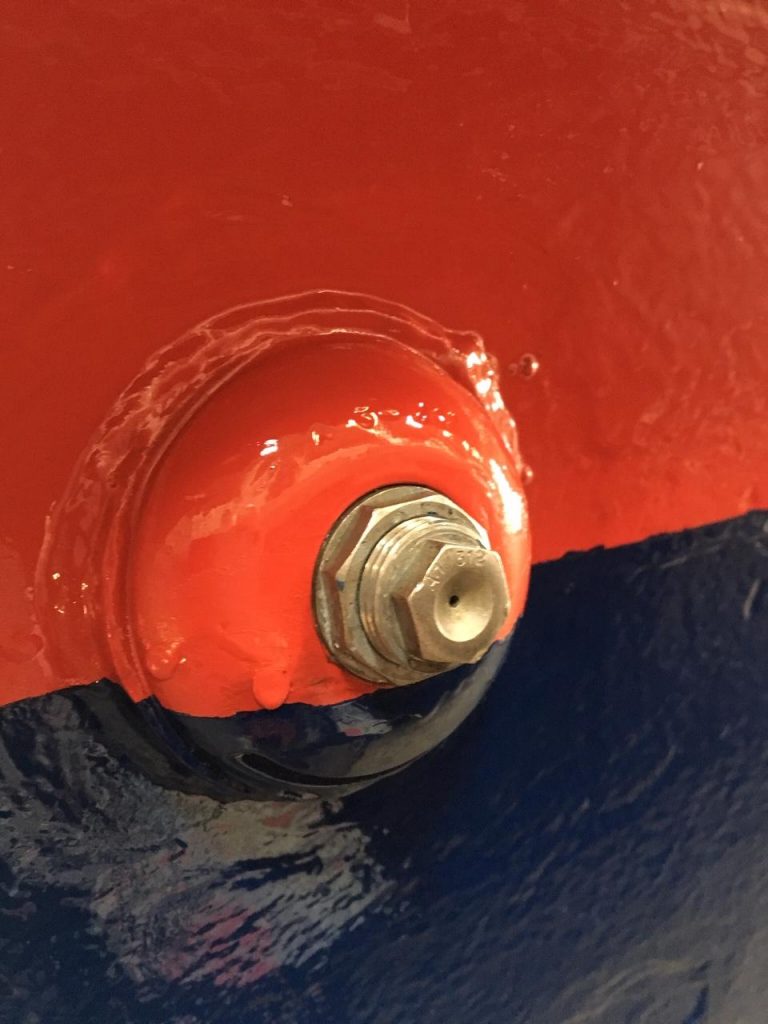The hull on ON1008 “James And Mariska Joicey” as on all eleven of the Solent Class Lifeboats is made from 1/4″ (6mm) Cor-Ten (weathering) Steel over a steel rib framework and all the pates are joined using electric arc welded butt joints. This type of construction was initially used in the RNLI on the twenty one 44′ Waveney Class Lifeboats (built between 1964 – 1982), the first two 70′ Clyde Class Lifeboats, ON987, 70-001. “Charles H. Barrett (Civil Service No.35)” & 988, 70-002(1965 – 1966) and subsequently on the third Clyde Class Lifeboat, ON1030, 70-003, “city of Bristol” in 1973, one of the 52′ Arun Class Lifeboats, ON1100, 52-030, “Snolda” in 1986 and of course the whole of the forty 47′ Tyne Class Lifeboats built between 1982 – 1990.
This construction method produces an exceptionally strong and rigid hull structure, even with relatively thin plating as the supporting ribs beneath are very close together. A friend of ours (and generous first contributor to our Gofundme page) Jon Gale was an apprentice at the Camper & Nicholson boatyard in Gosport, Hampshire from the late 1960s and was involved in the construction of the four Solent Class Lifeboats being built there at the time ON1011 – ON1014. He told us how the large and heavy Cor-Ten Steel hull plate (approximately 6′ x 18″) were all lifted and formed by hand through heavy duty steel rollers to produce the complex double compound curves required on most of the plates, often to very tight curves, particularly in the complex propeller shaft tunnels. Exceptionally skilled craftsmen indeed and the welding is of exquisite, consistent quality. We have a professional welder friend in Coleraine, Wally the Welder, who has done some excellent work for us on ON1008 and he marvels at the superb welding that was achieved on these hulls in the late 1960s using comparatively simple arc welding equipment.

Due to the high Copper content of Cor-Ten Steel it is inherently resistant to corrosion in comparison to mild steel, for that reason it is used on most marine applications, shipping containers, architectural cladding and sculptures such as the famous “Angel of the North” by Anthony Gormley. It doesn’t necessarily need painting in certain applications where the copper mix allows for a very controlled weathering effect, hence it’s often known as “Weathering Steel”. For lifeboats and general marine use it most definitely is very thoroughly painted in high performance marine paints.
It is a testament to the build quality of the the hull on ON1008 that despite being stuck on a beach for over 12 years it was found to still in overall excellent condition once examined in the boat sheds under survey in Coleraine. A 3″ crack next to a later RNLI applied plate over an original sonar transducer mount was the only fault found on the hull itself, remarkable. The previous owners deserve great credit for keeping the hull so well maintained and painted prior to her being marooned ashore of course!
We did decide to have the four wheelhouse scupper drain shafts plated over on ON1008 with 1/4″ Corten steel plate where they exit the base of the hull. This is because one of the drain shafts developed a split and was leaking on relaunch in 2014, we don’t intend to take too many green waves into the wheelhouse so will rely on the small bore central drain on the wheelhouse floor. Although quite expensive to do both in terms of materials and of course using a coded welder, by capping the scupper drains we have eliminated any potential future issues in that area.
The Solent Class has excellent stability properties with a metacentric height of 3′ 4″ and a natural self-righting ability from any angle of capsize. An integral element in this is the massive cast iron keel of 12″ in width and 10″ depth, weighing some 4.6 tons and running over much of the hull’s length. This keel is securely bolted up to the hull onto a hardwood 1″ buffer by a series of large, specifically designed, high tensile through bolts.
The deck of the Solent Class is again constructed from Cor-Ten Steel and is welded integrally with the main hull structure. To this is welded and riveted steel bulwarks are attached at the forepeak and stern, with appropriate openings for fairleads and lines, including a bow roller for anchor line and chain recovery.

The superstructure is built from 1/4″ thick aircraft grade aluminium and is riveted to a steel lip on the deck plates and attached to internal watertight bulkheads at each end of the engine room and into the after cabin from the wheelhouse. The aluminium superstructure is further strengthened by aluminium rib sections that are riveted to the outer skin and the wheelhouse roof skin is riveted and bolted onto H section aluminium girders, further supported by aluminium columns to provide strength were the wheelhouse to be heavily impacted. The fore cabin, engine room, after cabin and various compartments are watertight to created buoyancy for the inherent self-righting ability of the Solent Class, the wheelhouse doors are partially watertight on the MK1 Solents and fully watertight on the MK2 versions but the boats will self right even if the wheelhouse is flooded anyway.
An interesting feature of the Solent Class Lifeboats and indeed many contemporary RNLI Lifeboats of the same period is the Wave Subduer system. This comprises of an oil tank in the engine room, the original tank was missing on ON1008 but a genuine replacement has been sourced. A hand pump mounted on the port side of the engine room bulkhead in the wheelhouse, this was missing on ON1008 but later located in a locker onboard the boat and refitted. From this pump the oil was fed by pipes to a jet on either side of the hull, the port jet was in place on ON1008 but the starboard was missing, however the new owner out in the Bahamas of the 52′ Barnet Class ON924 “John Gellatly Hindeman” (now Sea Terra) was removing the system from his boat and kindly sent it to us. When operated the oil (organic and originally Whale oil) would spurt out of the jets and cover the surface of the sea, subduing the ferocity of the waves. I’ve not seen the system in use so can’t provide any accolades as to it’s effectiveness but will try to find some contemporary anecdotes from RNLI crew if possible.


